PPC
5 Adaptable Buyer Persona Examples to Inspire Your Own

As a small business owner, your ability to understand and connect with your target audience is paramount. In fact, your success hinges on it!
By identifying your ideal customers’ needs, motivations, and pain points, you can gain insight into them on a deeper level and develop compelling messaging that resonates and drives results. This is where buyer personas come in.
In this article, we’re sharing five helpful buyer persona examples along with everything you need to know to build your own, including:
- The definition of a buyer persona
- Why creating these detailed profiles is important for your business
- Steps to create buyer personas
Let’s dive in!
What is a buyer persona?
A buyer persona is a fictional representation of your ideal customers that helps you and your team better visualize and communicate to your target audience.
Imagine you are the owner of a small plant container business. Perhaps there are three typical types of customers you currently have or target in your marketing:
- Individuals looking for seasonal plant styling for their homes.
- Local businesses that need plants for their shops and offices.
- People who gift plants for special occasions.
Now, for each of these, imagine you combine all the most common qualities into one fictional person representing that ideal customer. This generalized description is what we call a buyer persona. While the persona is fictional, the detailed profile is based on everything we know about our current and future customers.
Based on data and research, a buyer persona typically includes but is not limited to the following elements:
- Demographic information: Age, location, education, occupation, income, etc.
- Psychographic information: Values, interests, lifestyle, etc.
- Behavioral information: Goals, pain points, shopping habits, decision-making process, etc.
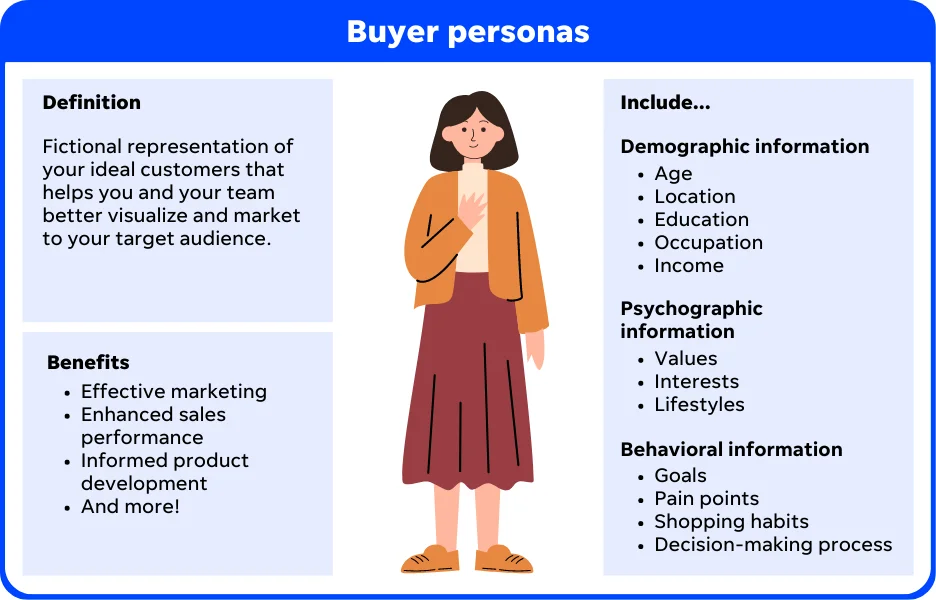
Why create buyer personas for your business?
Now that we’ve covered what buyer personas are, let’s look at why developing them is a crucial step for your business.
Buyer personas are essential for several reasons:
More effective marketing
As a small business, you are likely always looking to attract new customers. Buyer personas will provide the information needed to craft persuasive campaigns more likely to convert your prospects into long-term customers.
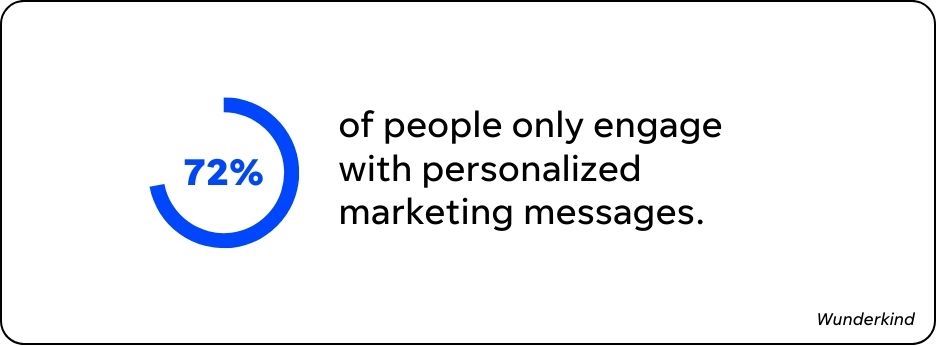
Enhanced sales performance
Buyer personas are an excellent sales enablement tool that will allow your sales representatives to visualize who your customers are and better understand them. These profiles will also provide them with data-driven background information to inform their messaging and discussions.
Informed product development
As you and your team use buyer personas in your sales and marketing efforts, the unique needs of your customers will become clear. You will then be able to pivot to focus your time on the most important and lucrative segments of your business, including opportunities for product development as well as product positioning.

For example, this search ad for The Farmer’s Dog suggests a product that’s geared toward pet owners who are cautious about what they feed their dog and are looking for “human-grade” food.
Improved customer retention
Your customers’ experience is of the utmost importance. Using buyer personas, you can better personalize your sales and marketing efforts to delight your customers and keep them loyal to your business.
As you can see, creating buyer personas is critical for all aspects of your small business.
How to create buyer personas
Developing buyer personas for your small business can be simple. Follow these steps to get started.
Gather data
Gather demographic, psychographic, and behavioral data on your current customers and prospects. Helpful resources for this process could be historical or new customer surveys, intel from your sales team, analytics (website, social media followers, etc.), and any information you can glean from your competitors’ customer base (completing a SWOT analysis might be helpful here!).
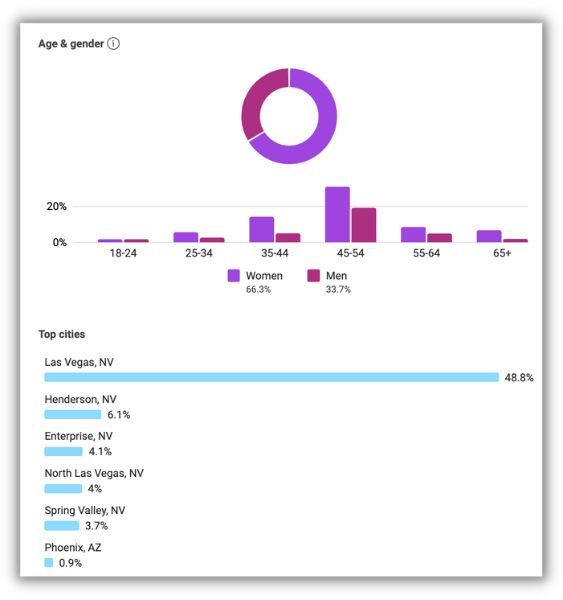
Hint: This will likely be the most time-consuming step in the process, but conducting thorough research is essential to creating helpful buyer personas.
Find similarities
Review your gathered data, identify patterns and commonalities, and organize into customer groups. For example, you may discover that many customers who purchase your plants as gifts are young professionals who prioritize convenience and price. This would be one of your key customer groups.
Build buyer personas
Develop detailed fictional characters to represent each customer group you created. For these profiles, the more details you can include, the better! You want the personas to be as realistic as possible to make them memorable for your sales and marketing teams.
Give them ages, hobbies, goals, challenges, and even a stock image of their appearance! When brainstorming names for your personas, consider using alliteration so your team can quickly recall them in their day-to-day work.

Refine and update regularly
The key to effective buyer personas? Keeping them up-to-date! The last thing you want to do is spend all the time researching and creating these detailed profiles, only for them to be obsolete a few months later. Regularly modify your profiles as your business evolves and your target audiences shift. Scheduling these updates (e.g., once per quarter) will help ensure you keep the personas relevant and helpful for your team.
Investing time into developing accurate and memorable buyer personas can increase customer acquisition and loyalty, impacting your bottom line. So the effort you put forth will benefit your business in the long run.
5 buyer persona examples to inspire your development
Now that you know how to create them, let’s look at some buyer persona examples to inspire your marketing. We’ve created these examples for a landscaping and nursery business that operates in multiple locations across the country, but you can adapt them to your needs based on your customer research.
Frugal Frankie
- Age: 25
- Location: New York, New York
- Occupation: Associate Product Manager
- Income: $65,000
- Interests: Music, crocheting, social media
- Goal: Send sustainable, cost-effective gifts to out-of-town family members
- Pain points: Limited funds, avoids large retailers (prefers supporting eco-friendly options with low carbon footprint), physical distance from gift recipients
- How we help: To appeal to Frankie, sales discussions and marketing campaigns should focus on low-cost plant options, convenient online ordering with gift messages, and environmentally conscious local delivery.
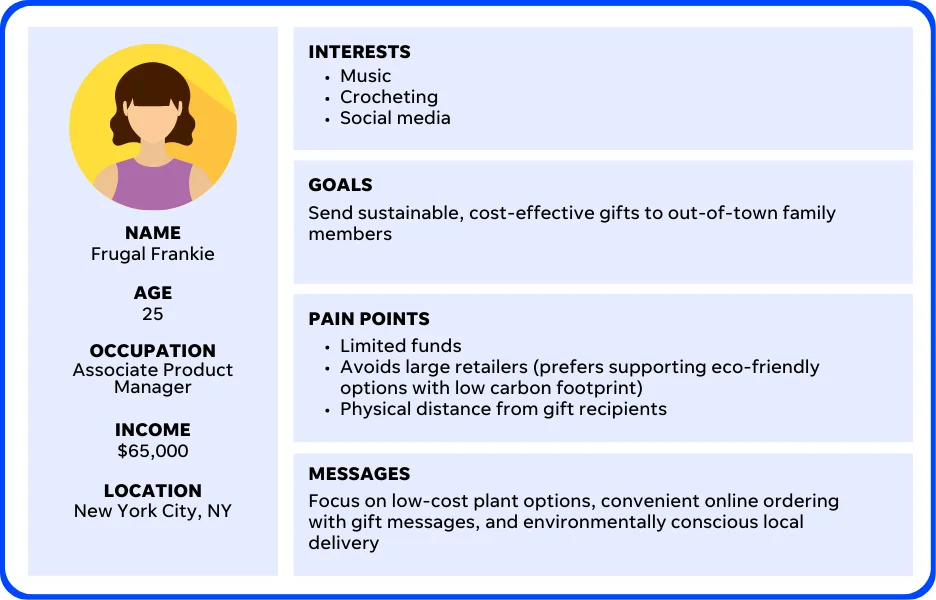
Go-Getter Gary
- Age: 48
- Location: Newton, Massachusetts
- Occupation: Emergency Room Nurse
- Income: $85,000
- Interests: Family life, fitness, travel
- Goal: Obtain seasonal home decor (indoor and outdoor).
- Pain points: Time constraints, wants a welcoming home environment for his family and guests but is too overwhelmed to research options, busy work and family schedule.
- How we help: To appeal to Gary, sales discussions and marketing campaigns should highlight seasonal plant examples, testimonials from other local customers, complimentary on-site styling consultations, and how he can save time with plant delivery and set-up.
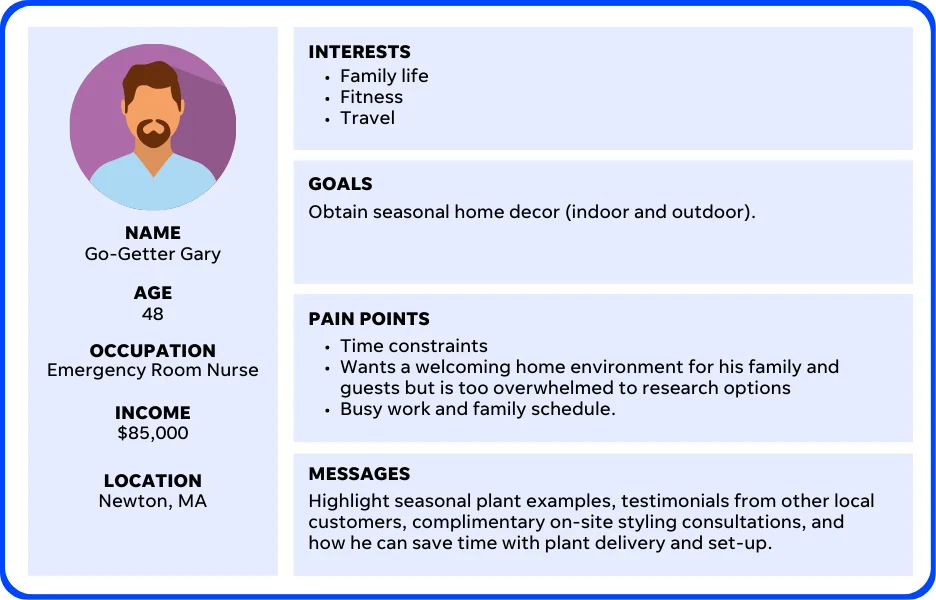
Bold Bonnie
- Age: 36
- Location: Whitefish, Montana
- Occupation: Bookstore Owner
- Income: $50,000
- Interests: Reading, philanthropy, DIY home projects
- Goal: Maintain indoor plants at the bookstore for an inviting atmosphere and improved air quality for a healthy reading space.
- Pain points: Doesn’t have a staff and wears many hats to run her business, limited knowledge of best plant options, and doesn’t have time for plant upkeep.
- How we help: To appeal to Bonnie, sales discussions and marketing campaigns should focus on educating her about the best plant options for improved air quality and the opportunity to set up a schedule for a team member to visit the bookstore for regular, reliable plant maintenance.

Homeowner Harry
- Age: 54
- Location: Clearwater, Florida
- Occupation: Vice President of Accounting
- Income: $220,000
- Interests: Antique cars, golf, luxury vacations
- Goal: Find low-maintenance outdoor plants that can increase the curb appeal of his home.
- Pain points: Doesn’t have time or interest in plant upkeep, unsure what plants to choose for the hot and humid climate.
- How we help: To appeal to Harry, sales discussions and marketing campaigns should focus on educating him about the best plant options for his area that are also low maintenance and the opportunity to set up a schedule for the team to maintain his front yard plants so he doesn’t have to.
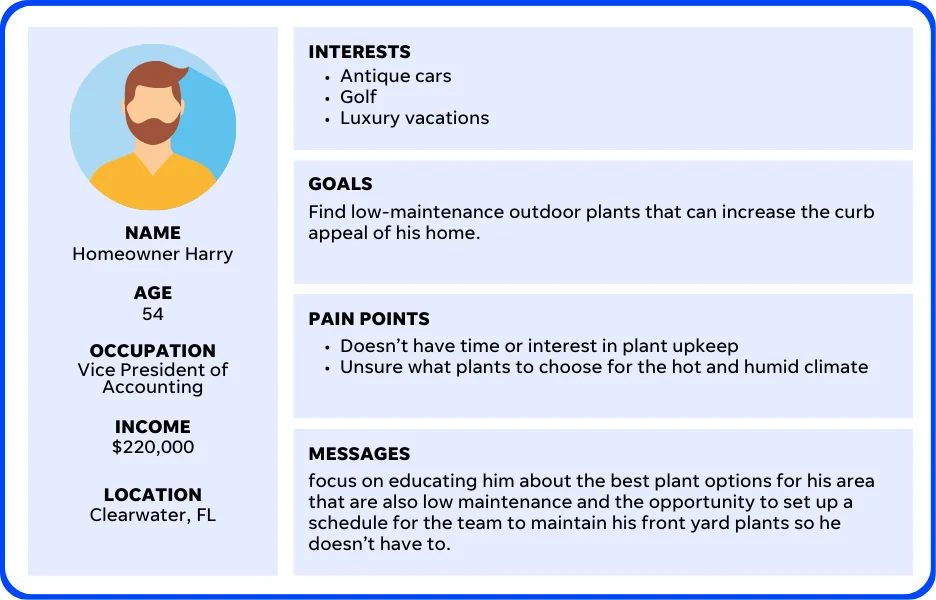
Stay-at-Home Sarah
- Age: 78
- Location: Phoenix, Arizona
- Occupation: Retired Teacher
- Income: $40,000
- Interests: Gardening, volunteering, spending time with her grandchildren.
- Goal: Find indoor plants to brighten her space now that she no longer has her own garden.
- Pain points: Recently moved to a retirement community and misses her gardening space. She’s looking for plants that require regular tending she can do inside.
- How we help: To appeal to Sarah, sales discussions and marketing campaigns should focus on educating her on the joys of indoor plant care and the best plants that require love and attention.

Create buyer personas for your business today
Your customers are human. By humanizing how you view your customer segments, you can more easily understand and connect with your target audience, attract new customers with your sales and marketing efforts, identify key areas for product development, and improve customer retention rates.
But don’t take our word for it. Use the buyer persona examples provided to inspire your development and see the results for yourself!


















